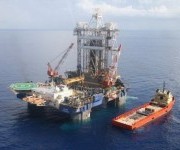
Updated
President Obama will open large swaths of the Atlantic, Gulf, and Alaskan coasts to offshore oil and natural gas drilling in a stunning concession to fossil-fuel companies, the New York Times, Los Angeles Times, Wall Street Journal, and others are reporting.
On Wednesday morning Obama and Interior Secretary Ken Salazar announced an end to a longstanding moratorium on oil drilling along the East Coast from Delaware to the central coast of Florida.
The Arctic Ocean north of Alaska will be opened too, while the Bristol Bay in southwestern Alaska would be protected—the sole new protection. New areas of the southeast Gulf Coast would also be opened, despite bipartisan opposition from political leaders in Florida and Alabama. The Times has a map of all of this, and you need to see it to comprehend the size of the affected area.
“This is not a decision that I’ve made lightly,” Obama said (full speech here). “…But the bottom line is this: given our energy needs, in order to sustain economic growth, produce jobs, and keep our businesses competitive, we’re going to need to harness traditional sources of fuel even as we ramp up production of new sources of renewable, homegrown energy.
This is … stunning. Baffling. With the new policy Obama appears to be taking a major step toward siding with carbon-polluting industries in the battle to defend the energy status quo.
I’m holding out hope that things appear worse than they are. Because the key isn’t how much offshore drilling is allowed. The crucial issue is whether oil and gas companies decide it’s worth their money to go out, find, and retreive the stuff. And things could be brighter on that front, because, as Joe Romm explains, the payoff in these reserves may not be worth the trouble. (Nobody knows precisely how much oil and gas are in these places.) GOP politicians like John McCain and Sarah Palin have used offshore drilling as a rallying cry, but energy companies need to keep clear heads, crunch the numbers, and decide if a given project pays.
A few more notes…
On gas prices and your money:
Not much will change for a long time—estimates figure that new oil won’t be available for 10 to 12 years, with peak production coming several years beyond that.
On foreign oil, energy independence, and bankrolling violent extremism:
Not much will change for a long time—again, the new oil won’t be available for years.
On the West Coast:
Dunno what’s going on here. No mention of it. [Update: The Pacific coast gets no mention because the drilling ban there remains in place.]
On the politics:
This is supposed to win support for a climate/clean-energy bill from wavering Senate Republicans. Obama compromises, they compromise—that’s the hope. But Republican lawmakers have shown very little interest in compromising on legislation in the Obama era.
So the big question is whether Democrats have gotten GOP senators to commit to supporting a bill. Did this win a few crucial votes, or is it a giveway for nothing? No one seems to know yet. No public vote commitments, at least.
The early reaction:
On the DailyKos comment thread, it’s mostly frustration with the apparent giveaway. “There’s no real level on which this is anything but pandering,” writes one commenter. “We need more oil like we need a hole in the head. In the ten years it takes to get it to market we could have renewables. Enough subsidies for big oil.”
The reporting:
The substances at issue here—oil and natural gas—will eventually be burned, releasing heat-trapping pollutants that cause global warming. If that continues unchecked, it could be the most destructive and unjust phenomena of the coming century. There’s no mention of any of this in the stories from major news outlets. Just sayin’.


